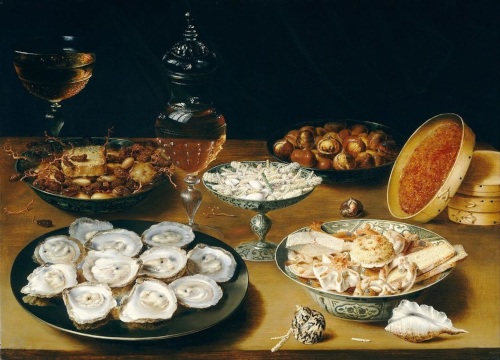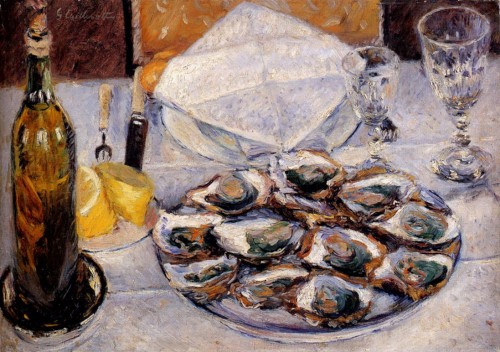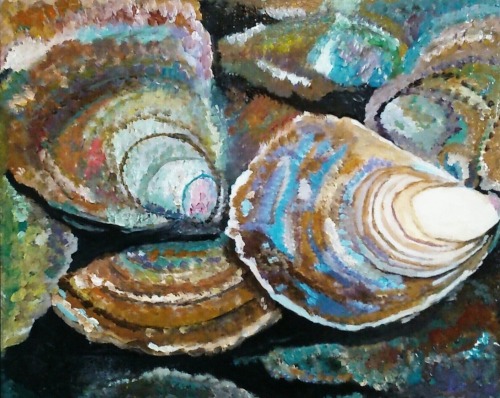Oysters During Antiquity
Oysters were farmed way back in ancient China. People would carve slits into bamboo sticks, attach shells to them, and place them in the sea. This was done so oyster larvae could latch on, serving as early forms of collection devices.
The taste of this seafood was already popular around the ancient Mediterranean. By the 5th century BC, Greeks used oyster shells as a way to vote someone out of their community. They wrote the name of the politician they wanted to banish on a shell. This practice later led to the term "ostracism."
Oyster Farming by Sergius Orata
Oysters Throughout History
The love for oysters came to Rome from Greece. Sergius Orata, an engineer and businessman around 140-90 BC, made oysters a luxury item by starting oyster farms. He set up these farms in Lake Lucrine, near Naples. The farms used wooden structures with ropes hanging from them where the oysters would attach and grow.
La Consommation d'Huîtres dans l' Antiquité Romaine
Back in Ancient Rome, fancy flat oysters were all the rage among the elite. They were so into them that they imported them big time, especially from the Marennes area in Gaul, which they'd conquered. They set up these ponds all along what they called the "oyster route" (places like Clermont, Poitiers, Saintes, Jarnac) to keep the seawater flowing and the oysters fresh during the journey. Because of how their shells looked, the Romans nicknamed them "callibléphare," which means "beautiful eyelid." They were really into oysters back then. Archaeologists have found heaps of oyster shells at lots of old Roman villas. And get this, the Romans even used them to make bowls and jewelry!
Thetis Truffles
Thetis Truffles Oysters, once picked later than we do now, weren't eaten until they were eight to ten years old. People liked them raw by the sea, but further inland, because they took longer to get there and weren't as fresh, folks usually cooked them. The Romans really valued these oysters, and Cicero even talked down on anyone who wouldn't serve oysters at their table, showing just how fancy they were considered. Like wine, these oysters, named after the sea goddess Thetis, were seen as a sign of wealth and good taste."
Oysters in the Middle Ages
In the Middle Ages, within a society governed by ecclesiastical rhythm, oysters were considered a choice delicacy that did not constitute a sinful indulgence. Deemed a lean food, they could be eaten without moderation or guilt during the forty days of Lent or on Fridays. It was in the 16th century that oysters became a dish in their own right and not just an appetizer. People began to enjoy them at luncheons where only oysters were served

Le Déjeuner d’huîtres, Jean-François de Troy, 1735
L'huître dans l'histoire
Modern Era
During Louis XIV's time, oysters became a highlight of fancy French dining and were copied by royal courts throughout Europe. There's a well-known story about the king's chef who reportedly ended his life because a delivery of oysters didn't make it on time for the king's meal. English tourists in Paris were amazed by how oysters were kept fresh for their journey to the city: taken out of their shells and neatly placed in baskets lined with straw, arriving ready to be cooked into stews.
L 'Abondance des Huîtres Plates
au XVIIe siècle
Back in the 17th century, you could find flat oysters everywhere along our shores, particularly around the North Sea and the English Channel. There were so many of them that people thought they'd never run out. Because of this, nobody bothered with oyster farming; everyone just gathered what they needed from the wild beds.

Nature morte aux huîtres, Osias Beert, 1610
L'impact de l' Abolition de la gabelle sur les marais salants
The Revolution brought about the temporary end of the gabelle (the salt tax and royal monopoly) in 1790, diminishing salt's role in the French economy. This shift led to the revival of numerous salt marshes, now converted into salt pans. Consequently, flat oyster production soared, resulting in the overuse of oyster beds and the exhaustion of natural resources. To address this, new rules were implemented, affecting the local folks who relied on this industry for their living.
De la Street Food aux défis de l'Industrialisation
Back in the early 1800s, oysters were just as prized as they were in the opulent courts of Europe two hundred years before. But as times changed, oysters became part of the burgeoning street food culture popping up in Paris, London, and New York. By 1860, the quaint port of Whitstable in the south of England had sent a staggering 50 million tons of oysters to London. Come the end of that century, a million oysters a day were being gobbled up by New Yorkers. The mass production of oysters started causing a stir over in the States, not just because it was driving the oysters to extinction, but also because kids were being used to collect them. The harsh realities of these young oyster shuckers in Louisiana were captured in the early 1900s by photographer Lewis Hine, showing some workers were barely four years old.
Napoléon III
La Fondation de l'Ostréiculture Moderne
Napoleon III was the visionary behind oyster cultivation and its commercialization, setting the stage for today's oyster industry. He revamped the management of coastal waters and made lime treatment a common practice for collecting young oysters.

Nature morte aux huîtres, Gustave Caillebotte, 1881

Oysters Throughout History
The Rise and Fall of the Portuguese Oyster in Europe
At the same time, European oyster cultivators discovered a new, tougher type of oyster flourishing along the Portuguese shores. This hardier and quicker-growing variety soon took over two-thirds of the French oyster population on the Atlantic coast. Yet, during the 1970s and 80s, as global trade expanded, two parasites struck the European shores, almost eradicating this native species and triggering a major economic downturn in the oyster farming industry. Despite this, some oyster farms in France, particularly in the more disease-resistant Bay of Mont-Saint-Michel, have managed to persevere.
Recherchez la toile : Nature morte aux huîtres, Matisse, 1940
The Spread of the Japanese Oyster Across Europe
The Pacific oyster, brought over from Japan for its significantly higher resilience than its European relatives, was utilized to densely repopulate our shores, stretching from Brittany through Normandy to Charente-Maritime, and even around some lagoon areas like Thau. Its capability to thrive in both freshwater and marine settings has led to an impressive expansion for a species introduced merely around fifty years ago. With the effects of global warming and the increase in water temperatures, we're beginning to observe its migration towards the North Atlantic shores, progressively making its way to Germany, the Netherlands, and the coasts of Ireland.
The Oyster: A Thousand-Year Treat
Oysters have always been seen as a choice dish. This sophisticated shellfish, with a history spanning thousands of years, has been a staple at our tables since the days of old and will keep pleasing our palates as long as dedicated farmers commit to raising them.

